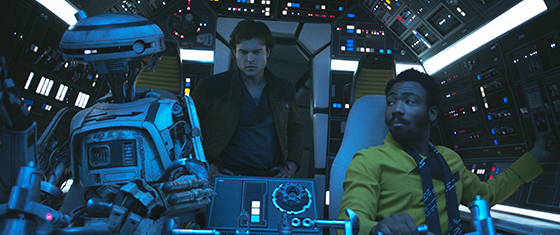Solo: A Star Wars Story
SOLO takes the idea first explored in George Lucas’ abominable prequels and runs it aground. It defies every rule of screenwriting…

Part of Disney’s ongoing effort to turn Star Wars into a perennial franchise, SOLO takes the idea first explored in George Lucas’ abominable prequels—explain away the magic—and runs it aground. It defies every rule of screenwriting—a damn shame, given that co-screenwriter Lawrence Kasdan also penned THE EMPIRE STRIKES BACK, arguably and still the best film of the entire franchise.
SOLO opens with an expository series of title cards that drag on longer than necessary. It reminded me of Mel Brooks’ SPACEBALLS’ satirization of the same. On the planet Correllia, we catch up with the titular hero (Alden Ehrenreich) in the middle of an adventure with his girl Qi’ra (Emilia Clarke) who, it seems, has a larger story to tell. He steals hyperfuel to make a living.
As to be expected, Qi’ra and Han are separated at a port of entry after trying to bribe a customs agent. From there, Solo finds an escape route joining the Imperial Forces as a crack pilot only to later join other deserters running a smuggling ring led by Beckett (Woody Harrelson) and his partner, Val (Thandie Newton, easily the best of the ensemble). They owe a debt to the notorious gangster, Dryden Voss (Paul Bettany).
There’s great casting at work everywhere but dead center. Ehrenreich’s blankness was perfect for the endearingly dumb Hobie Doyle in the Coen’s HAIL, CAESAR! But it doesn’t work with a character like Han Solo, whose principal trait is the ability to charm his way out of sticky situations.
But if there’s one thing I’m certain that the Star Wars franchise’s endless supply of white male fanboys is chiefly concerned with, it’s representation. Enter L3, Every robot in the STAR WARS universe is either gender neutral or male… and she’s the one robot in the galaxy Lando Calrissian (scene-stealer Donald Glover) is in love with. It’s not that Glover and Phoebe Waller-Bridge don’t have chemistry (second only to Harrelson and Newton). The producers and filmmakers have made overtures about inclusivity, at once declaring Lando “pansexual” while ultimately opting for the safer Disneysexual relationship—between a human and non-human (e.g. Wanda and Vision in AVENGERS: INFINITY WAR).
To endcap this middling drudgery is a visual style comprised of shot-reverse shot ad nauseum, and masters juxtaposed with illogical coverage. Completely baffling, given the editor (Pietro Scalia; THE MARTIAN, JFK) and DP (Bradford Young; SELMA). It feels ripped apart by studio notes (edicts from the producers or studio executives), resulting in some scenes that are utterly incomprehensible and others that are just lifeless, especially when compared to the brilliant rework done by Marcia Lucas on the original STAR WARS (1977) which rescued that film from complete disaster.
Ultimately, though, the central failure of SOLO is one of misunderstanding its principal character. Like George Lucas’ over-wrought explanation of The Force in his STAR WARS prequels, the difference between Han Solo and, say, Indiana Jones, is that Professor Jones underplayed his adventures. When we were introduced to Han Solo 41 years ago among a menagerie of characters crawling in and out of their libations at a seedy bar at the Mos Eisley spaceport, one got the sense that he exaggerated his exploits as often gangsters, thugs and smugglers do. Solo’s swagger is bigger than his blaster, yet diminished here with every wink and nod, including a groan-inducing answer to a question that never existed prior to 1997.
Of course Han shot first. But what was he doing just prior to that? Trying, unsuccessfully, to schmooze his way out of paying off Jabba. Dead Rodians tell no tales.